5 ways to use garden planters (plus potscaping tips)
As I was photographing Diane and Robbie Perry’s garden in Kent, I admired the way they use garden planters to add punctuation and colour. They’ve used garden pots in five ways:
- To fill gaps in borders
- To frame a door or pathway
- Add colour where you want it
- To grow plants that you couldn’t grow in your soil
- Grouped together in a ‘potscape’ to create a big impact
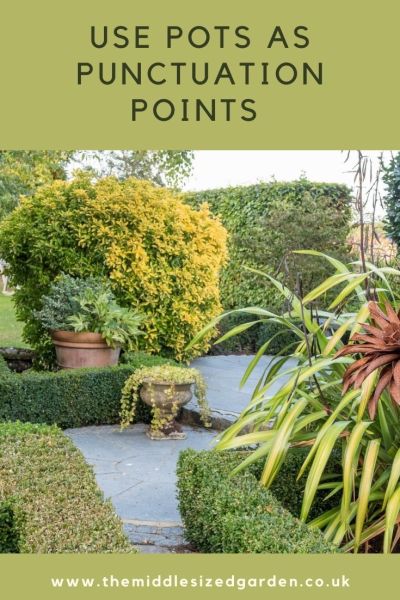
This corner combines a small paved area with evergreen hedging, and the evergreen pots adds punctuation and interest because their leaves are a contrast to the big hedge behind.
Fill a gap in your border with a garden planter
At the end of the summer, Diane says that gaps appear in her borders. Either she’s had to cut something back or the perennials are going over. And it’s too late to add anything to a herbaceous border, so she wedges in a pot or garden planter.
‘I use some old concrete planters which we inherited with the house,’ she says. ‘They disappear into the borders. It’s a good way of using less glamorous pots.’ She has added easy-to-find plants, such as pelargoniums to create the splash of colour.
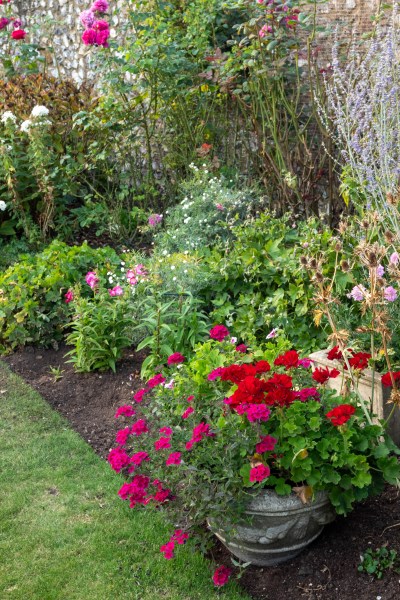
The pink and red pelargoniums in this concrete garden planter add a pop of colour to a border that is ‘going over’ at the end of the season.
Use your best garden planters to frame something
While Diane buries the less glamorous garden pots in the border, she invested more on the two main pots on either side of the front door. ‘It used to be a non-space,’ she says. ‘And it’s also quite narrow, so my options for big pots were limited.’
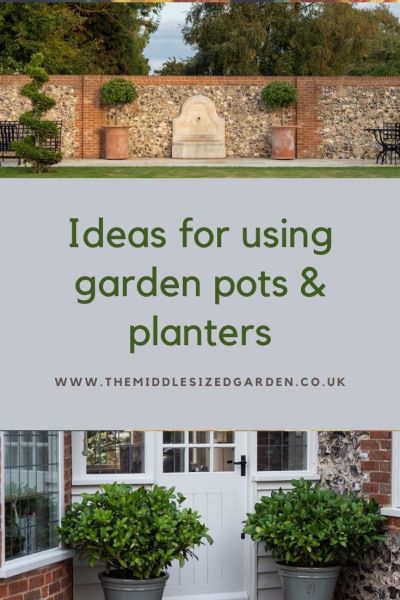
Two smart RHS garden planters sit on either side of the front door. Diane has also chosen matching pots to frame a water feature against a wall.
For more ideas on different garden planters and pots, see 25 inspiring and practical ideas for container gardens.
Use garden pots to add colour to your patio, terrace or border
Diane plans and re-plants her pots around twice a year – once for summer and once for winter. But as individual plants go over, she’ll replace them in between.
Changing or adding plants that are in flower now is a great way of adding colour, even if you have to change a couple of pots over every month.
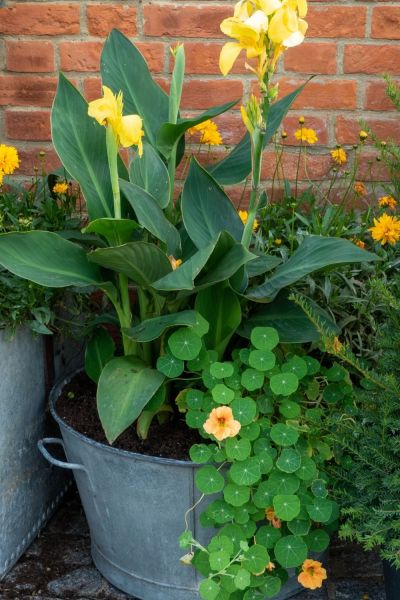
This grouping of yellow plants is part of Diane’s major pot display. The yellow flowers and galvanized zinc garden planters make a pretty contrast. Cannas are a showy plant with beautiful structural leaves, but they wouldn’t add much to a display until late summer. So you’d probably have a spring or early summer flowering plant in this spot earlier on in the season.
Use pots for plants you find difficult to grow in the garden
Many of us can’t grow hostas, except in pots. It’s easier – mostly – to keep slugs and snails away from hostas in pots than it is when they’re planted in the earth.
And garden planters are very useful for plants that need acid soil, such as rhododendrons, azaleas, skimmias, camellias and blue hydrangeas. It really is quite difficult to change the pH of your soil to grow these plants if they don’t grow well for you. Pots are the answer.
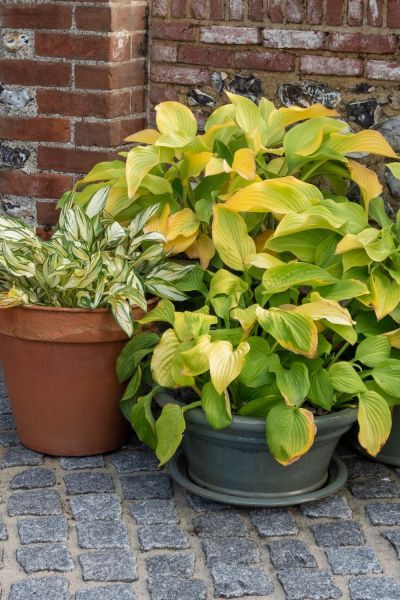
Diane has a good collection of hostas in pots. She says that the key to keeping them looking good is daily watering and feeding twice during the growing season.
What is potscaping?
Potscaping is ‘landscaping for pots’, or arranging groups of pots in attractive ways.
Before I became a garden blogger, I wrote books about homes and interiors, such as ‘Upcycled Chic & Modern Hacks’ and ‘Thrifty Chic’. At the time, the words ‘tablescape’ and ‘mantelscape’ were just emerging, as people started to arrange their mantelpieces and tables for Instagram photos.
Note: links to Amazon are affiliate, so I may get a small fee if you buy, but I only recommend products I use myself (or wrote myself). And it doesn’t affect the price you pay.
But I digress. Back to potscaping. Diane groups her pots in similar blocks of colour. The terracotta pots are at one side of the potscape and the galvanized zinc on the other, with a few black plastic pots concealed in the general prettiness.
She starts with the larger pots at the back – mostly. Occasionally she brings one forward to provide vertical interest.
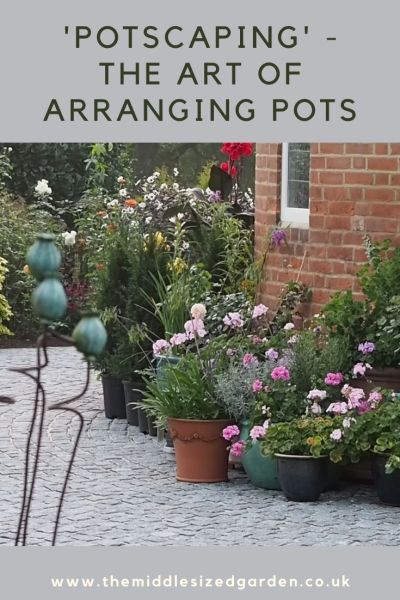
Diane grouped together her terracotta and ceramic pots on one side of this potscape. She planted them up with soft pinks and purples flowers.
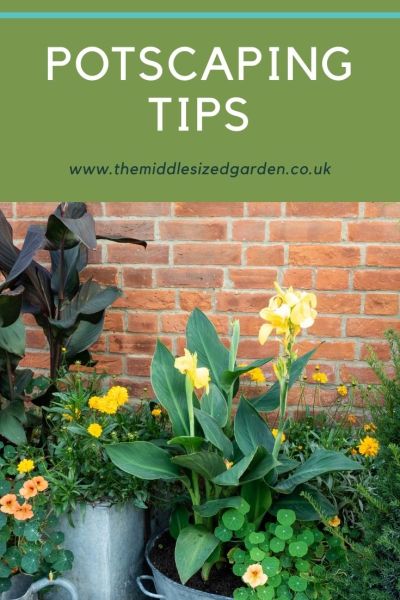
The yellow flower scheme and zinc garden planters are grouped together at the other end of the potscape.
Diane advises you to add evergreen structure to your potscape. She has some conifer cones, which add a sculptural element and can stay in their pots for several years until they outgrow them. Then you can plant them in the garden.
There’s more about evergreen pots in this post here.
Garden planter basics
If you want your garden planters to look beautiful almost all year round, then Diane recommends the following:
- Buy frost proof pots with good drainage
- Water your pots every day, but make sure you don’t over-water them. Some of Diane’s plants are in pot saucers. If the pot saucer fills with water then the plant is being over-watered.
- Feed your pots around twice a year. Plants in pots only have the nutrition you give them. They can’t get their roots down into the soil.
- Dead-head regularly and switch plants around once the flowers are over.
- You can reduce some of the work by mixing low maintenance plants with plants that offer beautiful flowers. Find out more about low maintenance plants for pots here.
See more of Diane’s garden and garden planters in video
There are more views of Diane and Robbie’s garden in this video. You can also see it in winter in How to use easy topiary shapes in stylish ways (blog post) or in video.
Shop my favourite garden products, tools and books
I’m often asked for recommendations, so I’ve put together lists of gardening books, tools and products I use myself on the Middlesized Garden Amazon store.
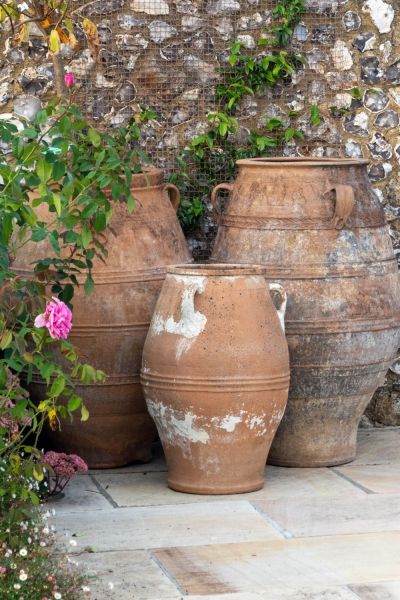
And don’t forget that pots and urns can look very good grouped together, even if they don’t have any plants in them.
Pin to remember ideas for garden planters
And do join us every Sunday morning for more gardening tips, ideas and inspiration. See how to follow by email here.
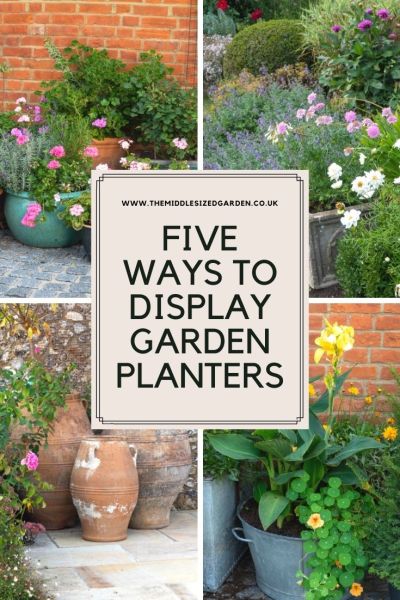
























With pots in saucers, is it best to keep filling the saucer with water or to water the actual plant, or a mixture of both.
Don’t fill the saucer, water the plant by pouring water directly onto the compost. There shouldn’t be water in the saucer – if the saucer fills up you have probably over-watered the pot. That doesn’t matter so much in a hot summer as the plant will take up the water or it will evaporate, but in winter, you shouldn’t allow plants to sit in saucers full of water. You are often advised to put plants on pot feet in winter so that they drain properly, but I think that just removing the saucer in winter should help. The saucer helps conserve water in summer, but there is often too much rain in winter, so get rid of the saucers in cold rainy months. I hope that helps.